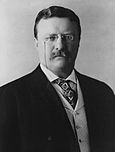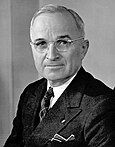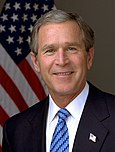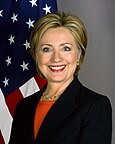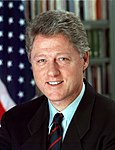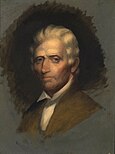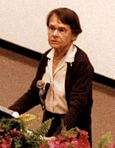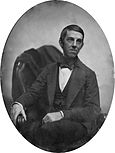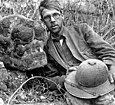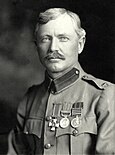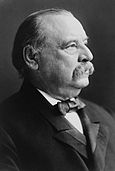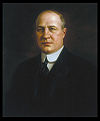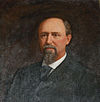Portal:United States/Selected biography
Selected society biographies list
1–25
Selected biography 1
</noinclude> Portal:United States/Selected biography/1
Born in
Selected biography 2
</noinclude> Portal:United States/Selected biography/2
In many ways Coolidge's style of governance was a throwback to the passive presidency of the nineteenth century. He restored public confidence in the White House after the scandals of his predecessor's administration, and left office with considerable popularity. As his biographer later put it, "he embodied the spirit and hopes of the middle class, could interpret their longings and express their opinions. That he did represent the genius of the average is the most convincing proof of his strength."
Selected biography 3
</noinclude> Portal:United States/Selected biography/3
Gerald Rudolph Ford Jr. (July 14, 1913 – December 26, 2006) was the thirty-eighth President of the United States, serving from 1974 to 1977, and the fortieth Vice President of the United States serving from 1973 to 1974. He was the first person appointed to the vice presidency under the terms of the 25th Amendment, and became President upon Richard Nixon's resignation on August 9, 1974. Ford was the fifth U.S. President never to be elected for the position of President, but the only U.S. President to not even be elected as Vice President or President.As president, Ford signed the Helsinki Accords, marking a move toward détente in the Cold War, even as South Vietnam, a former ally, was invaded and conquered by North Vietnam. Ford did not intervene in Vietnamese affairs, but did help extract friends of the U.S. Domestically, the economy suffered from inflation and a recession under President Ford. One of his more controversial decisions was granting a presidential pardon to President Richard Nixon for his role in the Watergate scandal. In 1976, Ford narrowly defeated Ronald Reagan for the Republican nomination, but ultimately lost the presidential election to Democrat Jimmy Carter.
Selected biography 4
</noinclude> Portal:United States/Selected biography/4
A native of Honolulu, Hawaii, Obama is a graduate of Columbia University and Harvard Law School, where he was the president of the Harvard Law Review. He was a community organizer in Chicago before earning his law degree. He worked as a civil rights attorney in Chicago and taught constitutional law at the University of Chicago Law School from 1992 to 2004.
As president, Obama signed
Selected biography 5
</noinclude> Portal:United States/Selected biography/5
On December 1, 1955, Parks became famous for refusing to obey bus driver James Blake's order that she give up her seat to make room for a white passenger. This action of civil disobedience started the Montgomery bus boycott, which is one of the largest movements against racial segregation. In addition, this launched Martin Luther King Jr., who was involved with the boycott, to prominence in the civil rights movement. She has had a lasting legacy worldwide.
Although Parks' autobiography recounts that some of her earliest memories are of the kindness of white strangers, her situation made it impossible to ignore racism. When the Ku Klux Klan marched down the street in front of her house, Parks recalls her grandfather guarding the front door with a shotgun. The Montgomery Industrial School, founded and staffed by white northerners for black children, was burned twice by arsonists, and its faculty was ostracized by the white community.
Parks received most of her national accolades very late in life, with relatively few awards and honors being given to her until many decades after the Montgomery bus boycott. For example, the Rosa Parks Congressional Gold Medal bears the legend "Mother of the Modern Day Civil Rights Movement".
Selected biography 6
</noinclude> Portal:United States/Selected biography/6
She became the First Lady of the United States in January 1981 following her
Selected biography 7
</noinclude> Portal:United States/Selected biography/7
As president, Reagan implemented new political initiatives as well as economic policies, advocating a
Selected biography 8
</noinclude> Portal:United States/Selected biography/8
Franklin Delano Roosevelt (January 30, 1882 – April 12, 1945), often referred to by his initials FDR, was the thirty-second President of the United States. Elected to four terms in office, he served from 1933 to 1945, and is the only U.S. president to have served more than two terms of office. He was a central figure of the 20th century during a time of worldwide economic crisis and world war.During the
Roosevelt won four presidential elections in a row, causing a realignment political scientists call the
Selected biography 9
</noinclude> Portal:United States/Selected biography/9
As Assistant Secretary of the Navy, Roosevelt prepared for and advocated war with Spain in 1898. He organized and helped command the 1st U.S. Volunteer Cavalry Regiment, the Rough Riders, during the Spanish–American War. Returning to New York as a war hero, he was elected Republican governor in 1899. He was a professional historian, a lawyer, a naturalist and explorer of the Amazon basin; his 35 books include works on outdoor life, natural history, the American frontier, political history, naval history, and his autobiography.
Selected biography 10
</noinclude> Portal:United States/Selected biography/10
Harry S. Truman (May 8, 1884 – December 26, 1972) was the thirty-third President of the United States (1945–1953). As vice president, he succeeded to the office upon the death of Franklin D. Roosevelt.During World War I he served as an
As president, Truman faced challenge after challenge in domestic affairs. The tumultuous reconversion of the
Selected biography 11
</noinclude> Portal:United States/Selected biography/11
George Walker Bush (born July 6, 1946) is an American politician and businessman who served as the 43rd president of the United States from 2001 to 2009. A member of the Republican Party, he previously served as the 46th governor of Texas from 1995 to 2000.The eldest son of the 41st president George H. W. Bush and a member of the Bush family, he flew warplanes in the Texas Air National Guard in his twenties. After graduating from Harvard Business School in 1975, he worked in the oil industry. He later co-owned the Texas Rangers of Major League Baseball before being elected governor of Texas in 1994. As governor, Bush successfully sponsored legislation for tort reform, increased education funding, set higher standards for schools, and reformed the criminal justice system. He also helped make Texas the country's leading producer of wind-powered electricity. In the 2000 United States presidential election, he won over Democratic incumbent Vice President Al Gore, despite losing the popular vote after a narrow and contested Electoral College win that involved a Supreme Court decision to stop a recount in Florida. (Full article...)
Selected biography 12
</noinclude> Portal:United States/Selected biography/12
Raised in
Selected biography 13
</noinclude> Portal:United States/Selected biography/13
Clinton was born and raised in
Selected biography 14
</noinclude> Portal:United States/Selected biography/14
Selected biography 15
</noinclude> Portal:United States/Selected biography/15
Thelma Catherine Ryan "Pat" Nixon (March 16, 1912 – June 22, 1993) was the wife of former President Richard Nixon and the First Lady of the United States from 1969 to 1974. She was commonly known as Pat Nixon.As First Lady, Pat Nixon promoted a number of charitable causes including
Pat's public appearances became rarer in her later life. She suffered two strokes within ten years of returning to California and was later diagnosed with lung cancer. She died in 1993.
Selected biography 16
</noinclude> Portal:United States/Selected biography/16
Raised on the
Selected biography 17
</noinclude> Portal:United States/Selected biography/17
George Washington (February 22, 1732 – December 14, 1799) was the first President of the United States, (1789–1797), after leading the Continental Army to victory over the Kingdom of Great Britain in the American Revolutionary War (1775–1783).Washington was chosen to be the
Selected biography 18
</noinclude> Portal:United States/Selected biography/18
McCain was a son of Admiral
Selected biography 19
</noinclude> Portal:United States/Selected biography/19
Daniel Boone was an American pioneer and hunter whose frontier exploits made him one of the first folk heroes of the United States. Boone is most famous for his exploration and settlement of what is now the U.S. state of Kentucky. Despite resistance from American Indians, for whom Kentucky was a traditional hunting ground, in 1775 Boone blazed the Wilderness Road through the Cumberland Gap and into Kentucky. There he founded Boonesborough, one of the first English-speaking settlements beyond the Appalachian Mountains. Before the end of the 18th century, more than 200,000 people entered Kentucky by following the route marked by Boone.Boone was a militia officer during the American Revolutionary War, which in Kentucky was fought primarily between settlers and British-allied American Indians. Boone was captured by Shawnees in 1778 and adopted into the tribe, but he escaped and continued to help defend the Kentucky settlements. He was elected to the first of his three terms in the Virginia General Assembly during the war, and fought in the Battle of Blue Licks in 1782, one of the last battles of the American Revolution. Boone worked as a surveyor and merchant after the war, but he went deep into debt as a Kentucky land speculator. Frustrated with legal problems resulting from his land claims, in 1799 Boone resettled in Missouri, where he spent his final years.
Selected biography 20
</noinclude> Portal:United States/Selected biography/20
Jim Bowie played a prominent role in the Texas Revolution, culminating in his death at the Battle of the Alamo. Countless stories of him as a fighter and frontiersman, both real and fictitious, have made him a legendary figure in Texas history.His rise to fame began in 1827 on reports of the
Bowie's reputation was cemented by his role in the Texas Revolution. After moving to Texas in 1830, Bowie became a Mexican citizen and married the daughter of the vice governor of the province. At the outbreak of the Texas Revolution, Bowie joined the Texas militia, leading forces at the
Selected biography 21
</noinclude> Portal:United States/Selected biography/21
.After the Civil War, Hancock's reputation as a soldier and his dedication to conservative constitutional principles made him a quadrennial Presidential possibility. His noted integrity was a counterpoint to the corruption of the era. This nationwide popularity led the Democrats to nominate him for President in
Selected biography 22
</noinclude> Portal:United States/Selected biography/22
During the 1940s and 1950s, McClintock discovered
Selected biography 23
</noinclude> Portal:United States/Selected biography/23
Lunney was a pivotal figure in America's manned space program from
Selected biography 24
</noinclude> Portal:United States/Selected biography/24
Surrounded by Boston's literary elite—which included friends such as Ralph Waldo Emerson, Henry Wadsworth Longfellow, and James Russell Lowell—Holmes made an indelible imprint on the literary world of the 19th century. Many of his works were published in The Atlantic Monthly, a magazine that he named. For his literary achievements and other accomplishments, he was awarded numerous honorary degrees from universities around the world. Holmes's writing often commemorated his native Boston area, and much of it was meant to be humorous or conversational. Some of his medical writings, notably his 1843 essay regarding the contagiousness of puerperal fever, were considered innovative for their time. He was often called upon to issue occasional poetry, or poems written specifically for an event, including many occasions at Harvard. Holmes also popularized several terms, including "Boston Brahmin" and "anesthesia".
Selected biography 25
</noinclude> Portal:United States/Selected biography/25
To his contemporaries, "Vay" Morley was one of the leading Mesoamerican archaeologists of his day. Although more recent developments in the field have resulted in a re-evaluation of his theories and works, his publications, particularly on calendric inscriptions, are still cited. In his role as director of various projects sponsored by the Carnegie Institution, he oversaw and encouraged many others who later established notable careers in their own right. His commitment and enthusiasm for Maya studies helped inspire the necessary sponsorship for projects that would ultimately reveal much about ancient Maya civilization.
Morley also conducted espionage in Mexico on behalf of the United States during World War I, but the scope of those activities only came to light well after his death. His archaeological field work in Mexico and Central America provided suitable
26–40
Selected biography 26
</noinclude> Portal:United States/Selected biography/26
In his later years he became especially known for his advocacy of controversial technological solutions to both military and civilian problems, including a plan to excavate an artificial harbor in Alaska using
Selected biography 27
</noinclude> Portal:United States/Selected biography/27
Sherman served under General
After the Civil War, Sherman became
Selected biography 28
</noinclude> Portal:United States/Selected biography/28
Born in
Bush met her future husband, George W. Bush, in 1977, and they were married later that year. The couple had twin daughters in 1981. Bush's political involvement began during her marriage. She campaigned with her husband during his unsuccessful 1978 run for the United States Congress, and later for his successful Texas gubernatorial campaign.
As First Lady of Texas, Bush implemented many initiatives focused on health, education, and literacy. In 1999–2000, she aided her husband in campaigning for the presidency in a number of ways, such as delivering a keynote address at the 2000 Republican National Convention, which gained her national attention. She became First Lady after her husband was inaugurated as president on January 20, 2001. (Full article...)
Selected biography 29
</noinclude> Portal:United States/Selected biography/29
Born into a
Foreign policy drove
Selected biography 30
</noinclude> Portal:United States/Selected biography/30
Frederick Russell Burnham, DSO (May 11, 1861 – September 1, 1947) was an American scout and world traveling adventurer known for his service to the British Army in colonial Africa and for teaching woodcraft to Robert Baden-Powell, thus becoming one of the inspirations for the founding of the international Scouting Movement.Burnham had little formal education, attending high school but never graduating. He began his career at 14 in the
Burnham eventually moved on to become involved in espionage, oil, conservation, writing and business. His descendants are still active in Scouting.
Selected biography 31
</noinclude> Portal:United States/Selected biography/31
Selected biography 32
</noinclude> Portal:United States/Selected biography/32
Smedley Darlington Butler (July 30, 1881 – June 21, 1940), nicknamed "The Fighting Quaker" and "Old Gimlet Eye", was a Major General in the U.S. Marine Corps, and at the time of his death the most decorated Marine in U.S. history. During his 34-year career as a Marine, he participated in military actions in the Philippines, China, in Central America and the Caribbean during the Banana Wars, and France in World War I. By the end of his career he had received 16 medals, five of which were for heroism. He is one of 19 people to twice receive the Medal of Honor, one of three to be awarded both the Marine Corps Brevet Medal and the Medal of Honor, and the only person to be awarded the Brevet Medal and two Medals of Honor, all for separate actions.Butler continued his speaking engagements in an extended tour but in June 1940 checked himself into a naval hospital, dying a few weeks later from what was believed to be cancer. He was buried at Oaklands Cemetery in West Chester, Pennsylvania; his home has been maintained as a memorial and contains memorabilia collected during his various careers.
Selected biography 33
</noinclude> Portal:United States/Selected biography/33
Frank Woodruff Buckles (born Wood Buckles, February 1, 1901 – February 27, 2011) was a United States Army corporal and the last surviving American military veteran of World War I. He enlisted in the U.S. Army in 1917 aged 16 and served with a detachment from Fort Riley, driving ambulances and motorcycles near the front lines in Europe.
During
In his last years, he was honorary chairman of the World War I Memorial Foundation. As chairman, he advocated the establishment of a World War I memorial similar to other war memorials in Washington, D.C. Toward this end, Buckles campaigned for the District of Columbia War Memorial to be renamed the National World War I Memorial. He testified before Congress in support of this cause, and met with President George W. Bush at the White House. (Full article...)
Selected biography 34
</noinclude> Portal:United States/Selected biography/34
Selected biography 35
</noinclude> Portal:United States/Selected biography/35
Selected biography 36
</noinclude> Portal:United States/Selected biography/36
Gerard K. O'Neill (1927–1992) was an American physicist and space activist. As a faculty member of Princeton University, he invented a device called the particle storage ring for high energy physics experiments. Later he invented a magnetic launcher called the mass driver. In the 1970s he developed a plan to build human settlements in outer space, including a space habitat design known as the O'Neill cylinder. He founded the Space Studies Institute, an organization devoted to funding research into space manufacturing and colonization. In 1965 at Stanford University he performed the first colliding beam physics experiment. While teaching physics at Princeton, O'Neill became interested in the possibility that humans could live in outer space. He researched and proposed a futuristic idea for human settlement in space, the O'Neill cylinder in "The Colonization of Space", his first paper on the subject. He held a conference on space manufacturing at Princeton in 1975. Many who became post-Apollo-era space activists attended. O'Neill built his first mass driver prototype with professor Henry Kolm in 1976. He considered mass drivers critical for extracting the mineral resources of the Moon and asteroids.Selected biography 37
</noinclude> Portal:United States/Selected biography/37
Selected biography 38
</noinclude> Portal:United States/Selected biography/38
Selected biography 39
</noinclude> Portal:United States/Selected biography/39
Selected biography 40
</noinclude> Portal:United States/Selected biography/40
Selected biography 41
Selected biography 42
Selected biography 43
Selected biography 44
Selected biography 45
Selected biography 46
Selected biography 47
Selected biography 48
Selected biography 49
Selected biography 50
Instructions
- Use template {{Portal:United States/Selected biography/Layout}}.
- Add a new Selected biography to the next available subpage.
Nominations
Nominations
Feel free to add FA-Class United States articles, A-Class United States articles, FA-Class biography articles and A-Class biography articles of Americans to the above list. Other United States-related biographies may be nominated here.
United States popular pages by WikiProject
</noinclude> The following United States WikiProjects include lists of popular pages - the top pages ordered by number of views in the scope of each WikiProject.
| National | Superfunds
|
| States | |
| Borders | Canada | Mexico |
| Government | Government | Congress | Supreme Court cases |
| Culture | Military history | National Register of Historic Places |
| Society | African diaspora | Asian Americans | Indigenous peoples of North America |
FA-Class society biography articles about Americans
![]() = Article added to portal.
= Article added to portal.
- Daniel Boone

- James Bowie

- Simon Bolivar Buckner
- Henry Cornelius Burnett
- Frederick Russell Burnham
- Wesley Clark
- Brian Eaton
- Gerald Ford

- Winfield Scott Hancock

- Benjamin Harrison
- William Henry Harrison
- Rutherford B. Hayes
- Thomas C. Hindman
- Thomas C. Kinkaid
- Eli Lilly
- John McCain
- George B. McClellan
- Fred Moosally
- Sylvanus Morley
- Edwin Taylor Pollock
- Ronald Reagan

- Uriel Sebree
- Lawrence Sullivan Ross
- Isaac Shelby
- William Tecumseh Sherman

- Myles Standish
- Edward Teller

- Benjamin Franklin Tilley
- Stephen Trigg
- Harriet Tubman
- Samuel Adams

- J. C. W. Beckham
- Daniel Boone

- William O'Connell Bradley
- Simon Bolivar Buckner
- Henry Cornelius Burnett
- Charles Carroll the Settler
- Murray Chotiner
- Wesley Clark
- Grover Cleveland
- Calvin Coolidge

- Richard Cordray
- John J. Crittenden
- Gerald Ford

- Wendell Ford
- William Goebel
- Emma Goldman
- John W. Johnston
- Franklin Knight Lane
- John McCain
- George B. McClellan
- Bob McEwen
- Thomas R. Marshall
- Harvey Milk
- Edwin P. Morrow
- Pat Nixon
- Barack Obama

- Rosa Parks

- Paul E. Patton
- Edwin Taylor Pollock
- Nancy Reagan

- Ronald Reagan

- Theodore Roosevelt

- Lawrence Sullivan Ross
- Terry Sanford
- Antonin Scalia
- Solomon P. Sharp
- Isaac Shelby
- Augustus Owsley Stanley
- Stephen Trigg
- Jerry Voorhis
- Daniel Webster
- Franklin D. Roosevelt
 (C-Class)
(C-Class) - Harry S. Truman
 (B-Class)
(B-Class)
- Edward Drinker Cope
- Oliver Wendell Holmes, Sr.

- David A. Johnston
- Eli Lilly
- Glynn Lunney

- Barbara McClintock

- Sylvanus Morley

- Gerard K. O'Neill
- Hilary Putnam
- Edward Teller

- Roman Vishniac
 (in Culture)
(in Culture) - Otto Julius Zobel
- Franklin D. Roosevelt
 (C-Class)
(C-Class)









